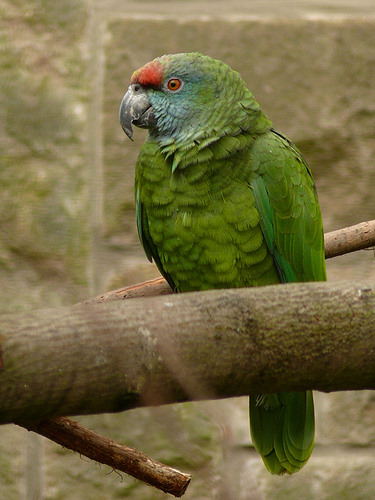
Festive amazon, or Festiveparrot, or Bodin's amazon(Amazona festiva bodini)
Phylum —chordata
Class — aves
Order — psittaciformes
Family — psittacidae
Genus – amazona
Appearance
Medium-sized, chunky parrot; typically appears entirely green with a contrasting red forehead. Smaller than Blue-cheeked parrot with darker face pattern and black bill. Festive parrot also lacks contrasting orange patch on wing and has a burrier, more nasal call than Blue-cheeked parrot. Size – 34 cm, weight – 370 g.
Habitat
It is found in Brazil, Colombia, Ecuador, Bolivia, Guyana, Peru, and Venezuela.
Behavior
Birds are not shy and quite noisy. They live in small flocks (up to 30 individuals). During mating, they are divided into pairs.
Diet
Festive amazon feeds on fruit and flowers, sometimes commuting long distances between feeding sites.
Reproduction
The breeding season is March-August. They nest in tree hollows. There are 3-5 eggs in a clutch. The incubation period is about 3 weeks. Be very careful when hatching eggs. Feeding lasts 8 weeks. Chicks fledge in two months.
In captivity
They live up to 70 years in captivity.
Keep the Festive amazon in a spacious cage or an aviary. The ideal size of the cage is such that parrots can fly freely in it (1x1x2,2 m). The cage must be locked with a strong and reliable lock so that the bird does not fly away. Inside the cage, you need to make several shelters in which the parrot will hide. It is desirable that the cage has an exit to the street, so that the amazon can spend time outdoors and take a sun bath.
Clean the amazon cage every day, and once a week you need to wash the contaminated areas of the cage, perches, toys. Also, you should replace the water in the drinking bowl with fresh water every day, and remove the remaining food from the cage. As parrots gnaw perches and branches they should be replaced.
Bathing parrots is vital for their plumage and skin. If the feathers are tarnished, it can be sprayed with fresh water from a spray bottle. After such a bath, leave the parrot to dry in a warm room or in the sun.
Amazons are fed granulated food with a high protein content. Fresh vegetables and fruits are added to the feed daily. When overfed, parrots become very picky about food. Because of their predisposition to obesity, amazons are given small amounts of sunflower or safflower seeds (only as a treat). If amazons are fed only seeds, they are additionally given vitamins and minerals to prevent the beriberi. It is preferable to add vitamins to soft foods rather than water, since such water serves as a good environment for the development of pathogenic bacteria.
High humidity is required during breeding. The minimum sizes of cages for breeding pairs: 2x1x2.20m, breeding house should be 25x25x60cm.Its bottom is covered with wood shavings for 10—20 cm. Sometimes some or all of the chicks have to be fed artificially. It is better to start artificial feeding when the chicks are 5-7 days old. During this period, parents will have time to provide their children with the necessary intestinal flora and enzymes that enter the stomachs of the chicks with food.
 Russian
Russian
 English
English























